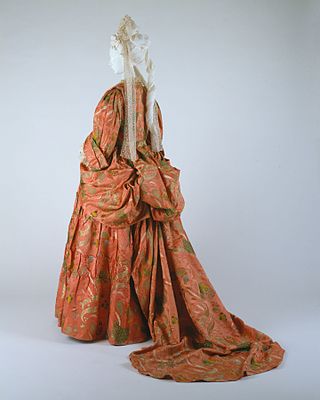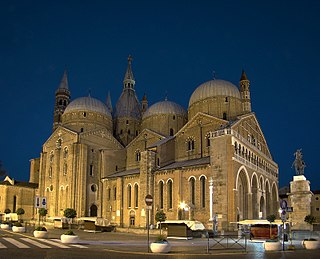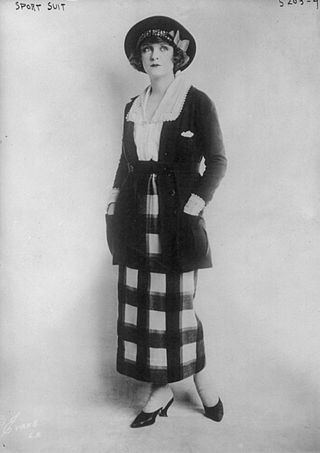
This is a timeline of Chinese history, comprising important legal and territorial changes and political events in China and its predecessor states. To read about the background to these events, see History of China. See also the list of Chinese monarchs, Chinese emperors family tree, dynasties of China and years in China.

A necklace is an article of jewellery that is worn around the neck. Necklaces may have been one of the earliest types of adornment worn by humans. They often serve ceremonial, religious, magical, or funerary purposes and are also used as symbols of wealth and status, given that they are commonly made of precious metals and stones.

A reliquary is a container for relics. A portable reliquary may be called a fereter, and a chapel in which it is housed a feretory or feretery.

A mantua is an article of women's clothing worn in the late 17th century and 18th century. Initially a loose gown, the later mantua was an overgown or robe typically worn over stays, stomacher and either a co-ordinating or contrasting petticoat.

The Pontifical Basilica of Saint Anthony of Padua is a Catholic church and minor basilica in Padua, Veneto, Northern Italy, dedicated to St. Anthony of Padua.
The page details the timeline of History of Iran.
This is a timeline of Japanese history, comprising important legal, territorial and cultural changes and political events in Japan and its predecessor states. To read about the background to these events, see History of Japan.

Sportswear is an American fashion term originally used to describe separates, but which since the 1930s has come to be applied to day and evening fashions of varying degrees of formality that demonstrate a specific relaxed approach to their design, while remaining appropriate for a wide range of social occasions. The term is not necessarily synonymous with activewear, clothing designed specifically for participants in sporting pursuits. Although sports clothing was available from European haute couture houses and "sporty" garments were increasingly worn as everyday or informal wear, the early American sportswear designers were associated with ready-to-wear manufacturers. While most fashions in America in the early 20th century were directly copied from, or influenced heavily by Paris, American sportswear became a home-grown exception to this rule, and could be described as the American Look. Sportswear was designed to be easy to look after, with accessible fastenings that enabled a modern emancipated woman to dress herself without a maid's assistance.

The Peribleptos Monastery is a late Byzantine-era monastery in Mystras, Greece. It was probably built in the mid-14th century by the first Despot of the Morea, Manuel Kantakouzenos, and named after one of the most celebrated monasteries of Byzantine Constantinople. The frescos in the main church, dating between 1348 and 1380, are a very rare surviving late Byzantine cycle, crucial for the understanding of Byzantine art. It is named after St. Mary of Peribleptos, of Byzantine, Constantinople (Istanbul). The Monastery is built into the side of a cliff with a cave supporting the structure. This architectural style is known as the "Mystras style" and is prevalent in several churches and monasteries in the area, this style is typified by a resemblance to a castle. It is constructed of squared stones with inlaid tiles. The complexity and unique variations of the shape of the structure of the exterior create an interior surface inside the monastery that lends itself to the ethereal quality of the frescoes covering the walls. These have been described as "delicate and subdued" in Byzantine Architecture and Decoration

Realism was an artistic movement that emerged in France in the 1840s, around the 1848 Revolution. Realists rejected Romanticism, which had dominated French literature and art since the early 19th century. Realism revolted against the exotic subject matter and the exaggerated emotionalism and drama of the Romantic movement. Instead, it sought to portray real and typical contemporary people and situations with truth and accuracy, and not avoiding unpleasant or sordid aspects of life. The movement aimed to focus on unidealized subjects and events that were previously rejected in art work. Realist works depicted people of all classes in situations that arise in ordinary life, and often reflected the changes brought by the Industrial and Commercial Revolutions. Realism was primarily concerned with how things appeared to the eye, rather than containing ideal representations of the world. The popularity of such "realistic" works grew with the introduction of photography—a new visual source that created a desire for people to produce representations which look objectively real.
The following is a timeline of the history of the city of Marrakesh, Morocco.

Sir James Dashwood, 2nd Baronet was an English politician who sat in the House of Commons from 1740 to 1768.

The Societé des artistes décorateurs was a French society of designers of furniture, interiors and decorative arts that was active from 1901 until the 2000s. It sponsored an annual Salon des artistes décorateurs in which its members could display their new work.
The following is a timeline of the history of the municipality of Utrecht, Netherlands.
The following is a timeline of the history of the municipality of Haarlem, Netherlands.

Woman with Parakeet is a painting by Pierre-Auguste Renoir created in 1871. It is in the holdings of the Solomon R. Guggenheim Museum in New York as part of the Thannhauser Collection. The painting portrays model Lise Tréhot, who posed for Renoir in over twenty paintings during the years 1866 to 1872.
The following is a timeline of the history of the city of Perugia in the Umbria region of Italy.
The following is a timeline of the history of the city of Rimini in the Emilia-Romagna region of Italy.

The turban helmet or Tolga in Turkish, is a historical variety of combat helmet with a bulbous shape and fluting that imitates the folds of a turban. Turban helmets originated in Ottoman Turkey, primarily used by warriors and some non-Turkish auxiliaries.

Süleyman the Magnificent's Venetian helmet was an elaborate headpiece designed to project the sultan's power in the context of the Ottoman–Habsburg rivalry. It was acquired by the sultan in 1532. The rivalry with the Habsburg monarchy was one of the most significant political and military relationships addressed by the sultan during his reign. In addition to military campaigns, Süleyman also took political and diplomatic steps in order to advance the Ottoman position, promoting trade with European powers and purchasing expensive jewels such as the helmet. The key figures behind the purchase of the helmet were Grand Vizier Ibrahim Pasha and his chief advisors, İskender Çelebi, the chief treasurer, and Alvise Gritti, a powerful jewellery merchant based in the Ottoman capital Konstantinyye, or Istanbul, as it was renamed in 1930.














